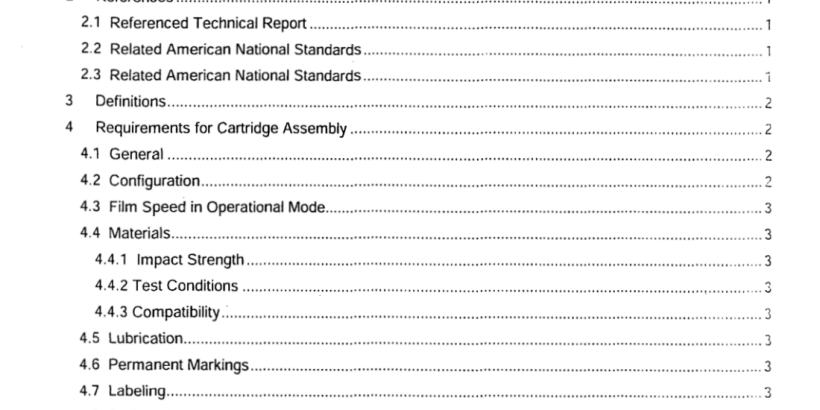ANSI AIIM MS15-2000 pdf download
ANSI AIIM MS15-2000 pdf download.American National Standard for Information and Image
Management
1 Scope
This standard specifies the physical and performance characteristics of cartridges used for storing and viewing processed 1 6 mm microfilm. The intent of the standard is to achieve compatibility between the cartridge and automatic threading readers and reader-printers. Accordingly, the standard addresses those physical features that interface with readers required to assure multi- reader usage. Also the winding of the processed microfilm on the reel and the physical character- istics of the leading end of the film are standardized to ensure proper interfacing of the cartridge with all readers of this type. This standard shall be used as a basis of design for future automatic threading readers and reader-printers to ensure that they accept the cartridges and film they contain over the full range of tolerances specified. For example, the readers and reader-printers shall accept film of all ranges of thickness allowed (see 5.4.2). This standard includes physical and optical compatibility requirements as well as test procedures.
2 References
All standards are subject to revision. When the following documents are superseded by an ap-
proved revision, that revision shall apply.
2.1 Referenced American National Standards
ANSIIAIIM MS1 4-1 996, Standard Recommended Practice -Specification for 16 mm and 35 mtii Roll Microfilm.
2.2 Other Related Publications
ANSVAIIM TR2-1 998, Glossary of Document Technologies.
IS0 6148: 1 993, Photography – Film Dimensions -Micrographics.
IS0 DIS 6148, Micrographic films, spools and cores.
2.3 Related American National Standards
ANSI IT9.2-1 991 , Imaging Media – Photographic Processed Films, Plates, and Papers – Filing
Enclosures and Storage Containers.
3 Definitions
The following definitions apply specifically to this standard. Additional terms are defined in
ANSIlAIIM TR2.
3.1 Automatic threading
The extraction of the leading end of the film and threading of the film by means built into the
reader and done without manual manipulation other than the manual operations associated with actuation or “starting” of the reader.
3.2 Core
The center cylindrical portion of the reel on which the film is wound.
3.3 Leading end of film
This refers to the precise end portion of the film in advance of the first image, or, if a separate (at-tached) leader is used, the precise end portion of the leader.
3.4 Shall
The word shallimplies a requirement.
3.5 Should
The word should implies a recommendation.
3.6 Single core
This term is used to identify a basic design feature of the cartridge defined in this document; that is, the cartridge has only a single reel and therefore a single core. This is a distinguishing feature as compared to the cassette, which has two cores.
3.7 Terminator
A coupling device such as a metal clip, hitch, boss, or ear attached to the leading end of the film for threading purposes.
3.8 Threading
Transferring the leading end of the film from the cartridge into the reader, around all idlers, rollers,and sprockets to the take-up device of the reader.
3.9 Trailing end of film
The portion of film beyond the last images recorded (also called trailed.
4 Requirements for Cartridge Assembly
4.1 General
The following requirements pertain to the cartridge (figure 1 or figure 3) assembled with a reel
(figure 2 or 2A) referred to as the cartridge. (All figures are after the annex.)
4.3 Film Speed in Operational Mode
There shall be no detrimental film scratches or other film damage on a 3 meter (IO foot) strip of film that has been transported at maximum reader speed back and forth for 25 look-ups (50 passes). This should be compared against reference prints made prior to the test at the start, middle, and end of the film strip. Suitable testing and checking shall be performed to determine whether such scratching or film damage, if it occurs, is caused by the functioning of the cartridge or by the reader transport system.
